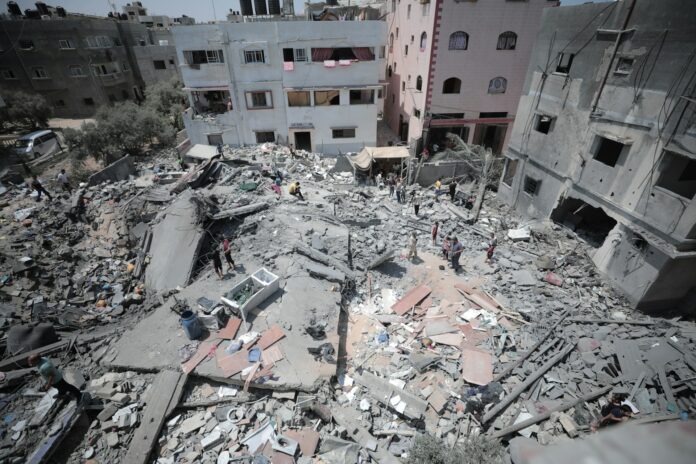Israeli forces withdrew after a 20-day operation in Jabalia; heavy casualties were reported across Gaza and West Bank
Scenes of devastation emerged from the Jabalia refugee camp in northern Gaza following the withdrawal of Israeli forces after a 20-day incursion. Palestinians inspected the extensive damage on Thursday, with buildings reduced to rubble. The Israeli military operation in Jabalia resulted in significant destruction and loss of life, underscoring the ongoing intensity of the conflict.
Over the past 24 hours, at least 53 Palestinians were killed, and 357 were wounded across the war-torn territory. The violence extended to southern Rafah, where Israeli forces continued bombing and invading. The conflict’s toll on civilians remains severe, with many areas left in ruins and countless lives upended.
In addition to the devastation in Gaza, Israeli forces conducted raids across the occupied West Bank. Areas such as Ramallah and Jenin were targeted, resulting in the death of a 20-year-old Palestinian man. Israeli settlers also carried out attacks on Palestinians near Jericho and Nablus, exacerbating the violence in the region.
The war has also affected international relations, particularly with Arab Americans. A recent poll revealed a significant decline in support for US President Joe Biden among this demographic. The ongoing US military support for Israel, including billions of dollars in weaponry, has sparked outrage and disapproval.
In southern Lebanon, the armed group Hezbollah launched six attacks on Israeli forces. Two Hezbollah fighters were killed in a firefight, further escalating tensions in the region. The conflict between Israel and Hezbollah adds another layer of complexity to the already volatile situation.
The US and UK militaries launched 13 air strikes on Houthi-controlled areas in Yemen, targeting what they described as Iranian-backed Houthi terrorist positions. The strikes aimed to prevent potential drone attacks on ships in the Red Sea, which the Houthis threatened to escalate in opposition to Israel’s actions in Gaza. The strikes hit locations in the capital Sanaa and the Hodeidah governorate, resulting in two deaths and ten injuries.
Analysis :
The current escalation in Gaza and the West Bank illustrates the deep-seated tensions and complex dynamics of the Israeli-Palestinian conflict. Politically, Israel’s military actions in Jabalia and across Gaza represent a continuation of its strategy to counteract perceived threats from militant groups like Hamas. The Israeli government justifies these operations as necessary for national security, aiming to dismantle the capabilities of groups launching attacks against Israeli civilians and infrastructure.
Economically, the conflict imposes severe costs on both sides. For Gaza, the destruction of infrastructure further debilitates an already struggling economy. The blockade imposed by Israel and Egypt exacerbates these economic hardships, leading to high unemployment and poverty rates. The international community’s response, including potential sanctions or aid, will significantly impact Gaza’s recovery and stability.
Sociologically, the violence further strains the social fabric of both Israeli and Palestinian communities. In Gaza, the trauma of war deepens societal divisions and hinders the development of a peaceful and cohesive society. In Israel, the fear and anxiety caused by rocket attacks reinforce hardline attitudes and complicate efforts towards a peaceful resolution. The international community, including organizations advocating for human rights, faces challenges in addressing these deep-rooted social issues.
From a local perspective, the impact on civilians is devastating. In Gaza, the destruction of homes, schools, and hospitals severely affects daily life and long-term prospects for recovery. The psychological toll on residents, particularly children, is profound. In the West Bank, the increased raids and settler violence exacerbate tensions, creating a volatile environment where clashes are frequent.
Gender perspectives are crucial in understanding the conflict’s impact. Women and children often bear the brunt of the violence, with disrupted access to healthcare, education, and basic necessities. The trauma experienced by these vulnerable groups requires targeted interventions and support from humanitarian organizations to address both immediate and long-term needs.
Race and minority perspectives also play a role in the broader regional dynamics. The conflict between Israel and Hezbollah in southern Lebanon reflects the intersection of ethnic and political tensions in the Middle East. The involvement of external actors, such as Iran’s support for Hezbollah and the Houthis, adds complexity to the conflict and highlights the broader geopolitical struggles influencing local disputes.
In conclusion, the recent developments in Gaza, the West Bank, and Yemen illustrate the multifaceted nature of the Israeli-Palestinian conflict and its broader regional implications. Addressing these issues requires a comprehensive approach that considers political, economic, sociological, local, gender, and minority perspectives. Sustainable peace and stability can only be achieved through concerted efforts by local actors, regional stakeholders, and the international community to address the underlying causes of the conflict and support the affected populations
